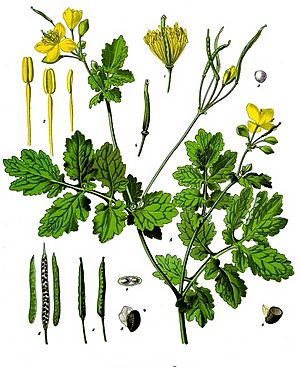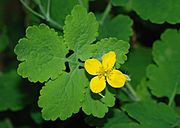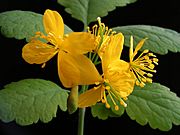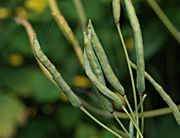Greater celandine facts for kids
Quick facts for kids Greater celandine |
|
|---|---|
 |
|
| Scientific classification | |
| Genus: |
Chelidonium
|
| Species: |
majus
|
| Synonyms | |
|
|
The Chelidonium majus, often called greater celandine, is a type of plant that lives for many years. It is a herb and belongs to the poppy family, known as Papaveraceae. This plant is one of only two species in its group, called Chelidonium. You can find it naturally in Europe and western Asia. It has also been brought to many parts of North America.
Even though it's called greater celandine and is in the poppy family, there's another plant called lesser celandine (Ficaria verna). Lesser celandine is actually part of the buttercup family, which is different.
Contents
What Does Greater Celandine Look Like?
The greater celandine is a plant that stands upright and can grow quite tall, from about 30 to 120 centimeters (about 1 to 4 feet) high. Its leaves are a pretty blue-green color. They are divided into smaller parts, like a feather, and have wavy edges. Each leaf can be up to 30 centimeters (about 1 foot) long.
The Plant's Special Sap
When you break a part of the greater celandine plant, it lets out a special liquid called latex, or sap. This sap can be yellow or orange. It's one of the plant's unique features.
Flowers and Seeds of the Plant
The flowers of the greater celandine have four bright yellow petals. Each petal is about 18 millimeters (less than an inch) long. The flowers also have two smaller leaf-like parts called sepals. Sometimes, you can even find a type of greater celandine with double flowers, which means it has more petals.
These flowers usually bloom from late spring through summer, typically from May to September in places like the UK. They grow in small clusters of about four flowers, shaped like an umbrella.
After the flowers, the plant produces small, black seeds. These seeds are held inside a long, tube-shaped pod called a capsule. Each seed has a tiny, fatty part called an elaiosome. This part attracts ants, which then carry the seeds away and help the plant spread. This process is called myrmecochory.
How Did Greater Celandine Get Its Name?
The famous scientist Carl Linnaeus, who is known as the "father of taxonomy" (the science of naming and classifying living things), officially described the greater celandine in his book Species Plantarum in 1753.
The Meaning Behind "Celandine"
The name "celandine" comes from an old Ancient Greek word, chelidṓn, which means "swallow" (the bird). Ancient writers believed that this flower started to bloom when swallows returned in the spring and faded when the swallows left in the fall. That's why it's sometimes called "swallowwort."
The greater celandine has also been called other names like "nipplewort" or "tetterwort." In a region of England called Devon, some people even call it "St John's wort," but this is different from the well-known St. John's wort herb.
Where Does Greater Celandine Grow?
The greater celandine is a native plant in most parts of Europe. You can also find it in North Africa, in places like Macaronesia, Algeria, and Morocco. In Western Asia, it grows in the Caucasus region, including Armenia, Azerbaijan, and Georgia. It's also found in Kazakhstan, Mongolia, Siberia, Iran, and Turkey.
Is Greater Celandine Invasive?
In some areas of North America, the greater celandine is considered an aggressive invasive plant. This means it can spread very quickly and take over areas where other native plants usually grow. For example, in Wisconsin, it is listed as a "restricted plant." To control its spread, people often pull the plants out or spray them before they can release their seeds.
Images for kids
See also
 In Spanish: Celidonia mayor para niños
In Spanish: Celidonia mayor para niños





